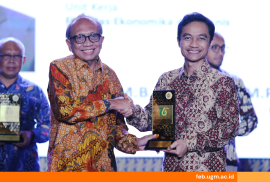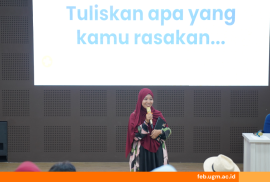
Successful businesses rarely emerge from sheer luck. They are built on thorough planning, a clear strategic roadmap, and the ability to assess risks. These points were highlighted during the Developing Business Mindset (DBM) session for new Pionir Simfoni FEB UGM 2025 program students on Wednesday (August 6). This session is an initial foundation for new students to develop an entrepreneurial mindset and understand how an idea can be transformed into a strategic and sustainable business model.
Azellia Alma Shafira, S.E., M.Sc., a lecturer from the Department of Management at FEB UGM, shared knowledge about The Art of Business Model Canvas (BMC) with the new students of FEB UGM. Known as Selly, she explained The Art of Business Model Canvas (BMC), a strategic tool developed by Strategyzer from Switzerland, to help entrepreneurs translate concepts, consumers, infrastructure, and finances into visual elements.
“BMC is similar to a business plan, but there are no exact elements, only strategic ones, and it is flexible according to business conditions. This tool is useful for coherently describing, designing, and changing business models,” she added.
“BMC is like a business plan, but without exact formulas. It is flexible, strategic, and can change according to conditions,” she explained.
Selly outlined the three main pillars of BMC: desirability (market and consumers), feasibility (internal capabilities), and viability (cost structure and revenue streams).
“The ideal business has all three of these components,” she added.
Selly explained that BMC consists of three elements: desirability, which describes the market and consumers or external factors; feasibility, which outlines business capabilities or internal factors; and viability, which covers the cost structure and revenue streams.
“An ideal business model has all three of these main components. They have products that are needed and desired by the market, can produce and deliver products, and have profit potential,” she explained.
During the BMC development process, Selly shared several essential tips. These include using concise points and numbers, ensuring logical connections and interrelationships between blocks, conveying a coherent narrative, recognizing audience understanding and expectations, and avoiding unnecessary jargon.
“The best planner never plans for the best; they plan for the worst,” she emphasized, highlighting the importance of realistic and adaptive business planning.
Reported by: Shofi Hawa Anjani
Editor: Kurnia Ekaptiningrum











